Ballast for fluorescent lamps: why is it needed, how it works, types + how to choose
When the ballast for fluorescent lamps (LL) fails, the lighting device ceases to function correctly. It can only be returned to normal mode by quickly replacing a damaged element with a working one.
You can buy the item in a specialized store, the main thing is to choose the correct modification module. Our article is devoted to the solution of this issue.
We will tell you what ballast is, what tasks it performs in the operation of a fluorescent lamp. We give a detailed classification, as well as describe the specifics of the functioning and application of different modules. We will help you find the right ballast taking into account the parameters of the lamp and the company of the manufacturer of the control device.
The content of the article:
Features of connecting LL to the network
A fluorescent lamp is a practical and economical module designed for organizing lighting systems in domestic, industrial and technical rooms.
The only difficulty is that it is not possible to directly connect the device to centralized power supply communications.

This is due to the fact that the creation of a persistent activating discharge in fluorescent lamps and the subsequent limitation of the increasing current require the organization of some specific physical conditions. These problems are solved by installing a ballast device.
What is ballast
Ballast is a device that regulates starting functions and connects fluorescent lighting devices to electrical communications.
It is used to maintain the correct operating mode and effectively limit the operating current.
It acquires increased relevance when there is insufficient electric load in the network and there is no necessary limitation when current is consumed.
The general principle of the element
Inside the fluorescent lamps there is an electrically conductive gas medium with negative resistance. This is manifested in the fact that with increasing current between the electrodes, the voltage decreases significantly.
Compensates for this moment and ensures the correct operation of the lighting device, which is connected to the ballast control system.

He also increases the overall voltage for a brief period and helps the luminescents light up when the resource is not enough for this in the central network. Additional functions of the module vary depending on its design features and type of execution.
Varieties and characteristics of ballasts
Today, electromagnetic and electronic ballast devices are most widely distributed. They work reliably and provide long correct functioning and comfortable operation of all types of fluorescent lamps. They have the same general principle of action, but differ somewhat in their individual capabilities.
Features of electromagnetic products
Electromagnetic ballasts are used for lamps connected to the mains using a starter.
The voltage supply in this embodiment is accompanied by a discharge, followed by intense heating and short circuit of the bimetallic electrode elements.
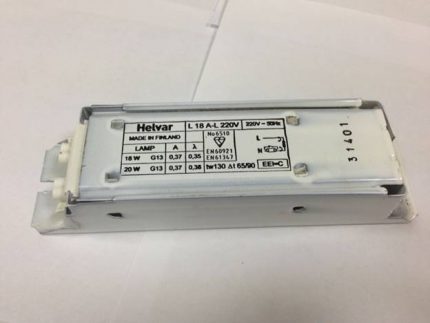
At the moment when the starter electrodes are shorted, the operating current increases sharply. This is due to the limitation of the maximum resistance of the choke coil.
After the starter is completely cooled, the bimetallic electrodes open.
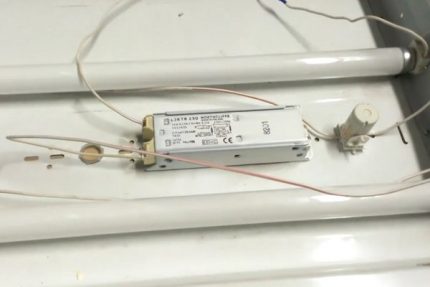
When the luminescent circuit is opened by the starter, an active high-voltage pulse is immediately generated in the induction coil and the lighting device is ignited.
The advantages of the device include:
- high level of reliability, proven by time;
- operational comfort of the electromagnetic module;
- ease of assembly;
- reasonable price, making the product attractive for manufacturers of light sources and consumers.
In addition to the positive aspects, users note an extensive list of disadvantages that spoil the overall impression of the device.
Among them are noted such positions as:
- the presence of the gating effect, in which the lamp flickers with a frequency of 50 Hz and causes an increase in the level of fatigue in a person - this significantly reduces performance, especially when the lighting device is located in a working or training room;
- the longer time required to start the lighting fixture - from 2-3 seconds at the beginning and up to 5-8 by the middle-end of the operating period;
- audible specific hum throttle device;
- increased electricity consumption, entailing an inevitable increase in utility bills;
- low reliability starter element;
- bulkiness of the structure and its significant weight.
When buying, all these conditions must be taken into account in order to understand what it will cost in the future to operate a household lighting system equipped with luminescent light.
Electronic ballast modules
Electronic ballast is used for the same purpose as the electromagnetic module. However, structurally and by the principle of the performance of their duties, these devices differ significantly from each other.
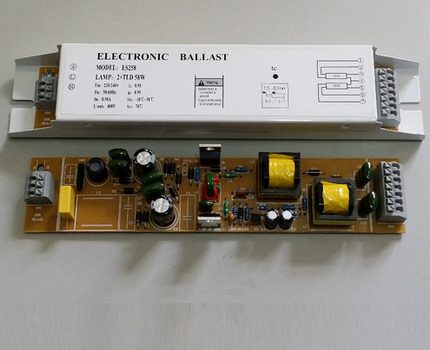
Wide popularity for products came in the early 90's. At this time, they began to be used in combination with a variety of light sources.
Initially, manufacturers compensated for the high cost compared with electromagnetic products by the good efficiency of the devices and other useful characteristics and properties.
The use of electronic ballasts made it possible to reduce the total consumption of electric energy by 20-30%, while preserving the saturation, power and light flux in full.
This effect was achieved by increasing the base light output of the lamp itself at an increased frequency and significantly higher efficiency of electronic modules compared to electromagnetic ones.
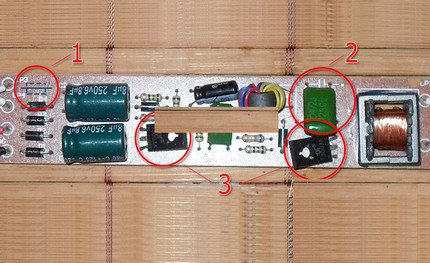
A soft start and a gentle operating mode made it possible to almost half-extend the luminescent life, thus lowering the overall operating costs of the lighting system. Lamps needed to be changed much less frequently, and the need for starters disappeared altogether.
In addition, with the help of electronic ballasts, it was possible to get rid of working background noises and pronounced annoying flicker, while at the same time achieving stable and uniform illumination of the rooms even with voltage fluctuations in the network within 200-250 V.

Additionally, it became possible to control the brightness of the lamp, adjusting the light flux to the individual desires and needs of the user.
Among the main advantages of the products, the following criteria stood out:
- light weight and compact design;
- almost instantaneous, very smooth inclusion, without exerting excessive load on the fluorescent lamp;
- complete absence of blinking visible to the eye and distinguishable noise effect;
- high power factor of 0.95;
- direct saving of electric current in the amount of 22% - the electronic module is practically not heated in comparison with the electromagnetic one and does not consume unnecessary resource;
- additional protection mounted in the unit to ensure a high level of fire safety, and reduce potential risks that arise during operation;
- significantly increased luminescent service life;
- light flow with good color density, without differences, even with prolonged burning, does not provoke eye fatigue of people in the room;
- high efficiency of the lighting device at negative temperature indicators;
- the ability of the ballast to automatically adapt to the parameters of the lamp, thereby creating an optimal mode of operation for itself and the lighting device.
Some manufacturers equip their electronic ballasts with a special fuse.It protects devices from voltage surges, fluctuations in the central network and erroneous activation of the lamp without a lamp.
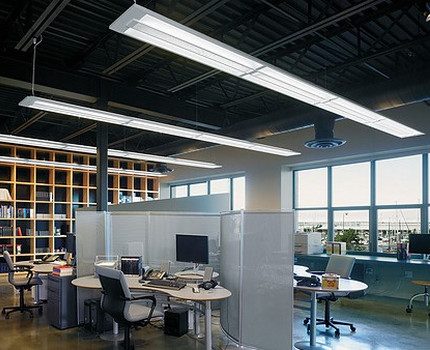
Of the minuses of electronic products, usually only the cost is mentioned, which is much higher compared to electromagnetic modules. However, this may only matter at the time of purchase.
In the future, in the process of intensive operation, the electronic ballast will fully work out its price and will even begin to bring benefits, seriously saving the electric resource and removing some of the load from the light source.
Ballasts for compact lamps
Fluorescent compact type lamps are devices similar to traditional incandescent lamps with a threaded socket E14 and E27.
They can be placed in modern and rare chandeliers, sconces, floor lamps and other lighting fixtures.
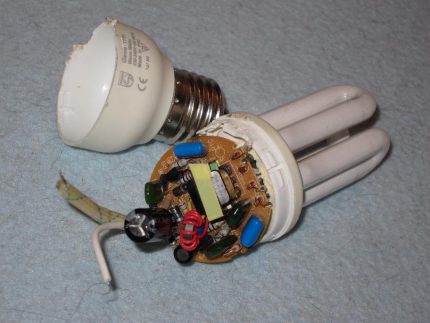
Instruments of this class are usually equipped with a progressive electronic ballast, which is built directly into the internal structure and is usually located on the board of the lamp product.
What to look for when choosing
When choosing a ballast for a fluorescent lamp, it is first necessary to pay attention to such a parameter as the module power.
It must fully coincide with the power of the lighting device, otherwise the lamp simply will not be able to fully function and give out light flow in the required mode.
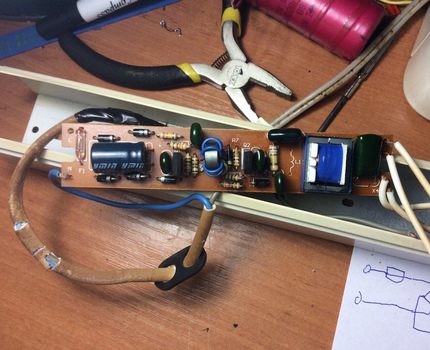
Next, you need to determine which ballast is required to be purchased. The price is more beneficial electromagnetic elements. Their cost is low and there are usually no difficulties with installation.
True, such devices are considered obsolete, have bulky dimensions and consume additional energy. This significantly reduces their attractiveness, even despite the affordable initial price.
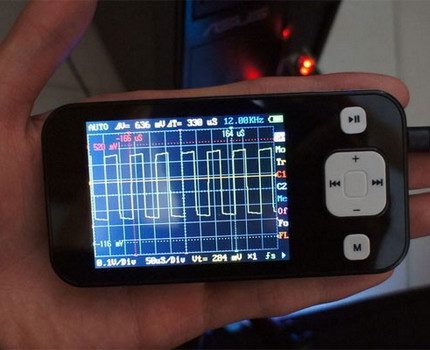
Electronic devices are much more expensive. This item especially applies to products manufactured by cool brand manufacturers. But their price is more than offset by energy efficiency, practicality, flawless assembly and a high level of overall instrument quality.
Ballast selection by manufacturer
The manufacturing plant is another significant criterion when buying. Do not focus solely on price and purchase the cheapest model from all that is offered in the store.
Features of branded ballasts
An unnamed Chinese-made product can very quickly fail and lead to subsequent problems with the operation of the bulb itself and even the lamp.
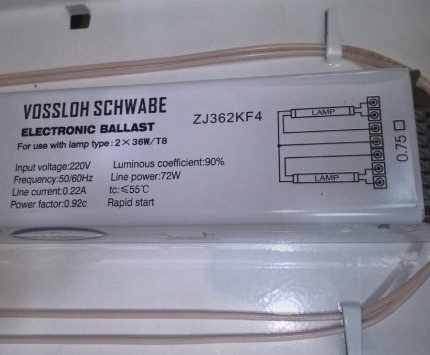
It is better to give preference to brands with a reliable reputation, which have proven themselves to be long-term work in the market of lighting equipment and related items.
Such devices will reliably work out the entire prescribed period, ensuring the full functioning of the luminescent in any lighting device.
Ballast products manufactured at enterprises of popular brands specializing in the manufacture of electrical equipment and related components have a strong and durable outer casing of a heat-resistant, deformable plastic composition.
Product marking degree of protection IP2 shows that the device has a good level of general security and is protected from getting foreign parts larger than 12.5 mm inside the box.
The operation of the device is comfortable and absolutely safe. The design completely eliminates the possibility of user contact with conductive elements.
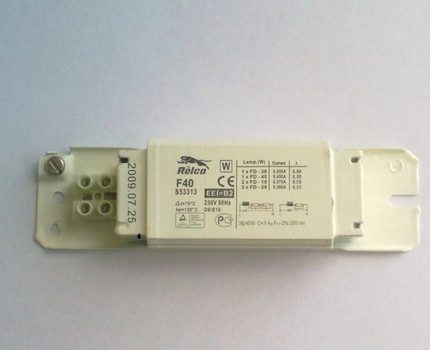
The normal temperature range for effective and continuous operation of the device is quite wide.
Brand ballasts cope with the tasks in cold weather, reaching -20 ° C and feel great on hot days, when the air heats up to + 40 ° C.
The best manufacturers of electromagnetic devices
Brand-name electromagnetic ballast devices are very popular with customers. E.Next.
This is due to the fact that the company offers truly high-quality, reliable and progressive modules made at the highest level in strict accordance with the requirements for equipment of this class.

The company gives a company guarantee on all products and offers customers high-quality service at all stages of cooperation.
No less in demand are electromagnetic ballasts created by the well-known and respected European manufacturer of electrical equipment and related components - the company Philips.
Products of this brand are considered one of the highest quality, reliable and efficient.
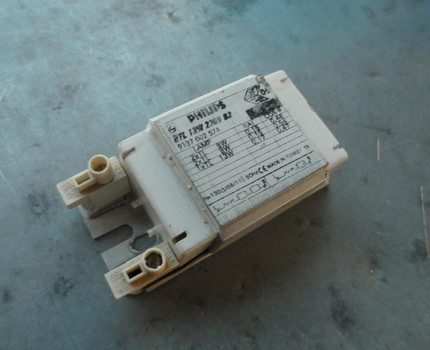
Philips ballasts help to save energy and neutralize the load that occurs during the operation of fluorescent lamps.
Actual electronic modules
Electronic products belong to the modern type of equipment and, in addition to traditional ones, also have additional functions. In this segment, the leading position is occupied by goods from a German company Osram.
Their cost is slightly higher than that of Chinese or domestic counterparts, but significantly lower compared to competitors such as Philips and Vossloh-schwabe.
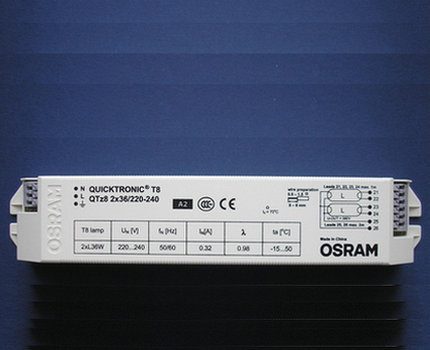
Among the budget branded modules, electronic ballasts stand out from the competition Horos.
Despite their loyal price, these items demonstrate high working efficiency and a good level of efficiency, eliminate the delay during ignition, minimize energy consumption and increase the light output of the lamp itself.
Using these tools, you can eliminate annoying flicker in fluorescent lamps and make lighting devices as convenient and operational-comfortable as possible.
A young, promisingly developing company does not lag behind the venerable old-timers of the market. Feron. It offers users European-level products at a very small, reasonable price.
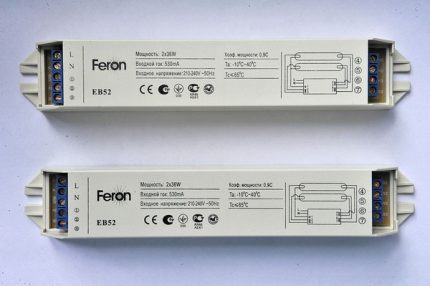
Feron's ballast-type devices protect lamps from unexpected electromechanical interference and power surges, eliminate flickering irritating to the eyes, and help save more than 30% of electrical energy.
Feron ballast controlled luminescence switches on / off instantly. No background sound effect is observed during operation. Lighting is soft, even and creates a pleasant, calm atmosphere around.
Conclusions and useful video on the topic
How an electronic device works in a fluorescent lamp. A detailed description of the device and the principle of operation of the product:
What is the difference between electromagnetic and electronic ballasts. The features of each of the modules and the specific nuances of their use in household lighting devices:
Features of the work of lamps equipped with ballasts of different types. Which elements are more effective and why. Practical recommendations and useful tips from the personal experience of the wizard:
To choose the right ballast for household fluorescent lamps, you need to know how this element is arranged and what function it performs. Having such information, as well as understanding the varieties of the device, it will be possible to acquire the necessary modification without any difficulties.
The cost of the module depends on the manufacturer, but even branded products have a quite loyal price and do not harm the budget of the average consumer.
Have experience choosing and replacing ballast in a fluorescent lamp? Please tell your readers which module you prefer and whether you are happy with the purchase. Comment on the publication and participate in discussions. The feedback block is located below.

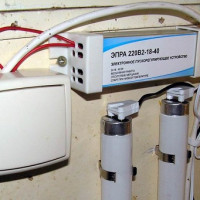 Electronic ballasts for fluorescent lamps: what it is, how it works, wiring diagrams for lamps with electronic ballasts
Electronic ballasts for fluorescent lamps: what it is, how it works, wiring diagrams for lamps with electronic ballasts 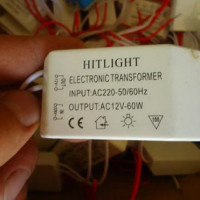 Transformer for halogen lamps: why is it needed, the principle of operation and connection rules
Transformer for halogen lamps: why is it needed, the principle of operation and connection rules 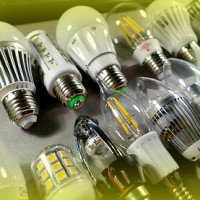 LED lamp bases: types, marking, technical parameters + how to choose the right one
LED lamp bases: types, marking, technical parameters + how to choose the right one  Inductor for fluorescent lamps: device, purpose + circuit for connecting
Inductor for fluorescent lamps: device, purpose + circuit for connecting 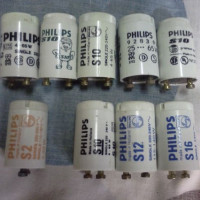 Starter for fluorescent lamps: device, principle of operation, marking + subtleties of choice
Starter for fluorescent lamps: device, principle of operation, marking + subtleties of choice 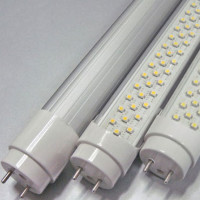 Replacing fluorescent lamps with LEDs: the reasons for the replacement, which are better, replacement instructions
Replacing fluorescent lamps with LEDs: the reasons for the replacement, which are better, replacement instructions  How much does it cost to connect gas to a private house: the price of organizing gas supply
How much does it cost to connect gas to a private house: the price of organizing gas supply  The best washing machines with dryer: model rating and customer tips
The best washing machines with dryer: model rating and customer tips  What is the color temperature of light and the nuances of choosing the temperature of the lamps to suit your needs
What is the color temperature of light and the nuances of choosing the temperature of the lamps to suit your needs  Replacement of a geyser in an apartment: replacement paperwork + basic norms and requirements
Replacement of a geyser in an apartment: replacement paperwork + basic norms and requirements
In our office, all fluorescent lamps work through electronic modules - ballasts. A good friend advised us, who works in a company selling and servicing electrical equipment. These electronic modules have an advantage in reliability, work for a very long time, rarely break. In size they are smaller than other species. This is the best ballast option.